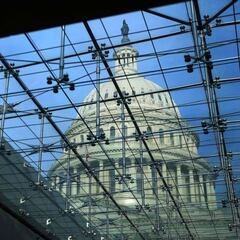What is the debt increase by president?
The US flirted again with what is known as the “x-date” when it can’t pay the bill on the debt the nation has accumulated. Where did the debt come from?

The US debt is the result of annual national deficits, spending more than the nation takes in, accumulating over the years. The national debt has come into the spotlight once again as the US came perilously close to what the US Treasury calls the “x-date”, when it no longer has the ability to pay for both its debt service and essential programs such as Social Security, thus going into default.
The US hasn’t always run deficits, and at one point in time the US nearly paid off its entire debt. Nor has the nation always flirted with defaulting on its obligation to pay creditors, the debt ceiling, responsible for the “x-date” when the Treasury can no longer borrow to pay the bills, was created in 1917 to control spending on the US involvement in World War I.
Also see:
- Fourth stimulus check in 2021?
- Congress faces three major economic deadlines
- Overview of the three federal stimulus checks and their impact
- Why is Washington DC the capital of the US?
Who and what has been increasing the US debt?
Because of an intentionally designed budget system the accounting for each president’s share of the debt doesn’t start until they make their first budget proposal which Congress passes with their own modifications. The first year of a new presidency usually depends on the spending approved under the prior president, giving the new president time to work with lawmakers on Capitol Hill to find funding for the new administration’s policy proposals.
The debt has increased under every president since Herbert Hoover in absolute dollar amount, although some presidents in the interim had years with surpluses. Policies to help the economy recover from a recession either through extra spending, tax cuts or both help push up the deficit and if not paid for over time the debt. But one major sinkhole for the United States' coffers has been war.
NEW: The Congressional Budget Office projects a massive $3 trillion US budget deficit for 2021 -- the 2nd largest since 1945.
— Heather Long (@byHeatherLong) July 1, 2021
CBO predicts ~$1 trillion annual deficits for the next decade. That could go higher if infrastructure isn't paid forhttps://t.co/Y6y3wzSHSL pic.twitter.com/ps0TFHNGdX
Currently, the US has amassed a debt surpassing $28 trillion, over $20 trillion of that built up since 2000. But depending on how you look at the debt, the most recent presidents, although their total dollar amounts are astronomical, aren’t necessarily the ones who raised the national debt the most.
Which presidents are responsible for the most debt?
There are two ways of looking at which president increased the debt the most. You can look at in absolute dollar amount which has skyrocketed in recent years, or as a percentage of increase over a presidency.
"Everyone seems to agree the US debt ceiling should be raised to pay for tax cuts and spending the government has already approved — and to avoid the economic calamity that would likely result from a US default. But Congress is tied up in knots" | Analysis https://t.co/zJqs6AqP8B
— CNN (@CNN) October 6, 2021
By percentage
Looking at percentages, the most fiscally responsible administration was under President Andrew Jackson who brought the national debt down by 99.42 percent over his two terms. The largest increase of the national debt was during President Abraham Lincoln which saw the national debt increase by over 2,859 percent, although he had the Civil War to contend with.
President Martin Van Buren, who oversaw a 1,458 percent increase in the national debt, takes second place percentage-wise, his predecessor was Jackson. During his twelve years in office President Franklin D Roosevelt increased the debt by nearly 1,048 percent which included spending on the recovery from the Great Depression and World War II.
Fact Checker: Why a debt ceiling breach would not be the first U.S. default https://t.co/n0cN9yiHno
— The Washington Post (@washingtonpost) October 7, 2021
Absolute dollar amount
Related stories
By dollar amount the three most recent presidents have added a combined total of nearly $23 trillion. During the past 20 years the US has had to dig out of two major recessions in which tax cuts and financial stimulus was used to bolster the economy. At the same time the US was involved in two major military operations and a global war on terror.
When President George W. Bush took office, the national debt sat at a little over $5.8 trillion and rose by 105 percent to $11.9 trillion during his two terms. President Barack Obama over eight years saw the debt jump another $8.3 trillion or increase nearly 70 percent. Spending to counter the covid-19 pandemic coupled with major tax cuts in 2017 resulted in the national debt rising by $8.7 trillion under President Donald Trump during his four years, the highest rise in absolute dollar terms.
- Barack Obama
- Franklin Delano Roosevelt
- Abraham Lincoln
- George W. Bush
- Donald Trump
- Covid-19 economic crisis
- Science
- Public debt
- Coronavirus Covid-19
- Economic crisis
- Deficit financing
- United States
- Pandemic
- Coronavirus
- Recession
- Budget deficit
- North America
- Economic climate
- Virology
- Outbreak
- Infectious diseases
- Public finances
- Diseases
- Microbiology
- America
- Finances
- Biology
- Health
- Life sciences
- Economy


